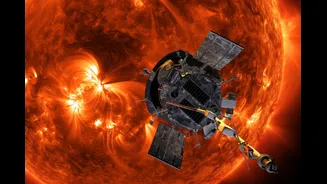Comet's Interstellar Origins
The comet 3I/ATLAS, originating from interstellar space, marked a significant discovery. Unlike comets originating from within our solar system, 3I/ATLAS came
from beyond, offering astronomers a unique opportunity to study material formed in other star systems. Its path through our solar system allowed for close observation, revealing insights into the composition and characteristics of comets from outside our local environment. This exotic visitor sparked excitement among scientists worldwide, as it allowed to analyze a relic of another star system.
Journey Through Space
3I/ATLAS embarked on a remarkable journey through space, drawing attention due to its origin. As it traveled, scientists closely monitored its trajectory and velocity, gathering data to understand its movement patterns. The comet's path took it through our solar system, offering astronomers a valuable chance to study its behavior under the influence of the sun's radiation and gravitational forces. This trajectory provided information about the comet's structure and the way it interacted with the surrounding space, greatly enhancing our comprehension of these celestial bodies.
Visibility and Movement
Tracking 3I/ATLAS involved understanding its visibility and movement across the night sky. The comet's appearance, which depended on its distance from the sun and Earth, shifted over time. Skywatchers needed precise information about its location, brightness, and movement to observe it effectively. The comet's path was carefully charted, allowing observers to locate it. This required diligent tracking to anticipate its changing position and the best times for viewing. Various resources were utilized to provide this crucial information, allowing both amateur astronomers and professionals to follow the comet's journey.
Scientific Significance Unveiled
The scientific community found the observation of 3I/ATLAS to be of great importance. The comet offered invaluable data to study the composition of interstellar bodies, their structure, and how they interact with their environment. The comet's presence also provided unique insights into the formation and evolution of other star systems, offering valuable clues about the conditions of early solar systems. The data acquired helped to enhance our comprehension of the vast universe and our place within it. Scientists analyzed the comet's nucleus, its tail, and the gases it released to gather information about its formation history and the materials it contains.
Visual Spectacle Emerges
When the Japanese space agency released an image of 3I/ATLAS, the visuals were widely shared. The comet's striking appearance captured global interest, as it showed a green hue, which is a result of the excitation of diatomic carbon molecules in the comet's coma. This phenomenon, along with the comet's apparent loss of its tail, generated curiosity among observers. The image sparked discussions among scientists and astronomy enthusiasts. This event emphasized the mesmerizing nature of comets and their appeal to human fascination, leading to numerous discussions and media coverage.
Missing Tail Mysteries
One of the most intriguing aspects of 3I/ATLAS was the apparent absence of its tail in some images. The reasons behind this disappearance are multifaceted. The comet's tail is formed by solar wind and radiation, which exert pressure on the dust and gas released by the comet. When the comet gets too close to the Sun, this tail can temporarily disappear due to various effects, including the way the comet's dust particles scatter sunlight. Moreover, the alignment of the comet with Earth can cause the tail to appear truncated or even invisible. These effects underscored the dynamic behavior of comets and the complexities involved in observing them.
Green Hue Explained
The green color observed in the coma of 3I/ATLAS is a result of chemical reactions occurring in the gases surrounding the comet's nucleus. These gases, particularly diatomic carbon molecules, absorb ultraviolet radiation from the sun, and subsequently re-emit this energy as green light. This fluorescence is a characteristic of many comets and gives them their ethereal, greenish glow. The intensity of this green light varies depending on the comet's distance from the sun and the amount of gas it releases. The green hue served as an immediate visual indicator and an intriguing clue that attracted numerous observers worldwide.













